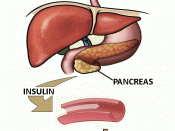Diabetes
Mugs Blank
May 22, 2001
Biology
4th Quarter Report�
Diabetes, a life long disease for which there is not yet a cure, is caused by reduced production of insulin, or by decreased ability to use insulin. Insulin, the hormone produced by the beta cells in the pancreas, allows blood sugar (glucose) cells to be able to use blood sugar. This hormone is necessary for glucose to go from the blood to the inside of the body cells. With inadequate insulin, glucose builds up in the bloodstream instead of going into the cells. The body is unable to use glucose for energy despite the high levels of glucose in the bloodstream. This causes the excessive thirst, urination, and hunger, which are the most common symptoms of diabetes. The excess sugar remains in the blood and is then removed by the kidneys. This disease occurs in several forms, but the most common are Type I Diabetes or Juvenile Onset Diabetes or Insulin-Dependent Diabetes Mellitus (IDDM), Type II or Non Insulin-Dependent Diabetes Mellitus (NIDDM), and Gestational Diabetes Mellitus.
In Type I Diabetes, the body is unable to store and use glucose as an energy source effectively. The pancreas secretes a hormone called insulin, as mentioned above, that helps lower blood sugar and aids in the passage of glucose out of the blood cells into body cells. Also with Type I Diabetes, the pancreas does not produce enough insulin, and within five to ten years after diagnosis, insulin-producing cells of the pancreas are completely destroyed causing absolute insulin deficiency. This type may occur in both sexes, but mainly manifests itself in children, teens, or young adults. This form can occur at any age, but usually happens before the age of thirty, and in lean people. Fifty percent of all people with Type...



Diabetes: All about the desease, its causes, effects, treatments, and possible future treatments.
Another interesting fact is that in many diabetic emergencies the patient will appear intoxicated. This is caused by decreased glucose to the brains tissues which in turn causes the brain's proper motor function to decline. It is important to remember that every decrease in mental status has an underlying cause which can be many other things than just drugs or alchohol. An assumption that a person who appears intoxicated must have been drinking may delay life saving medical intervention for a more serious condition.Your report was very impressive. With the amount of information included and the informations accuracy, I would bet that it would pass for a respectable grade at a much higher level than just the 11th grade.
12 out of 12 people found this comment useful.